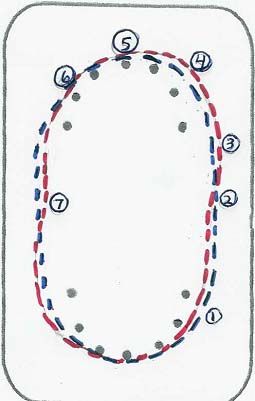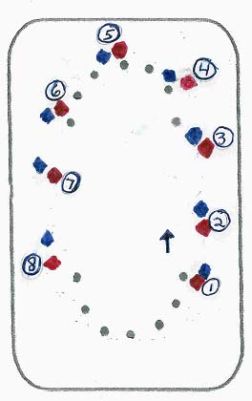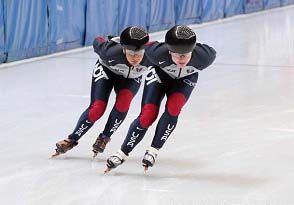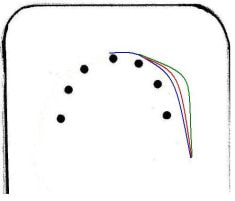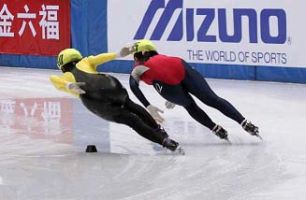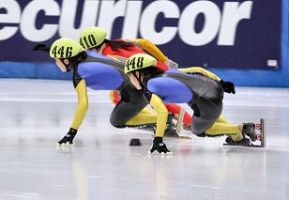The Inside Pass
By Susan Ellis, January 2006
Passing is an essential skill in short track skating, yet one that eludes many skaters, simply because they lack or haven’t practiced the proper set up procedure for the pass.
The inside pass is all about the set up. If it isn’t set up properly, it’s much tougher to execute. In days of old the pass was set up by creating a gap between you and the other skater on the ½ lap before the pass, and then trying to accelerate through the corner to close the gap and pass coming out of the corner. It is a tough way to time the pass. More often than not skaters get caught catching their opponent too early in the turn and have to pull out of the pass before the opening on the exit, or are too late catching them, and get caught still trying to complete the pass going in to the next corner.
One rule of thumb in passing – to pass, you must change your trajectory in to the corner from that of your opponent. Passing inside on the exit is much easier when you follow the opponent in to the corner with your inside shoulder lined behind their outside shoulder. You go slightly deeper in to the corner than them, come in directly behind them at or just after the apex, and slingshot up the inside on the exit as soon as a gap appears between them and the blocks.
Four reasons to follow in on the outside shoulder:
If the pack is very tight you may want to block up the exit so you don’t get passed by taking a path slightly to the inside shoulder of the person ahead as you exit the turn (#1 on diagrams). Before the center line you should have moved at least directly behind the skater (#2). Around the center line you should move to a position directly behind the outside shoulder of the skater (#3). Stay behind the outside shoulder and go slightly deeper in to the corner as you enter. (This creates a very slight gap that is easily closed by the speed generated from going deeper and wider) (#4).
At about the apex you start to come in directly behind the skater (#5). As soon as there is an opening (usually around block 6) you start to go by (#6). You should be past the other skater before the center red line (or the 2nd blue line at the latest) and continue to skate hard up the straightaway (#7). You swing back out towards the boards as early as possible to widen your trajectory again for your entry (#8).
Passing at the highest speeds is about commitment. You can’t just do half the set up and expect to get by. You may half the time, but the other half of the time you will not be successful. If you are going to go for it, then GO FOR IT!
To execute the pass consistently well you need to practice it consistently well. One mistake skaters make is to fall into the habit of complacency – complacent to just skate mindless laps, upon laps, upon laps. Sure you may get in great shape, but have no race skills. Good training habits build good racing habits.
A great program for learning and practicing inside passing is what I call the ½ Lap Passing Program. Skaters go in pairs (stick to pairs as much as possible as groups of three or more tend to complicate things). The pairs do a given number of laps, say 5 laps, and the goal is to execute a pass every ½ lap. That makes one pass per skater each lap. When you are first learning how to execute this, start out at only about 70% speed, and don’t intentionally block passes. Doing this program you get a better feel for the set up, the rhythm and timing of the pass, and get into the HABIT of passing. After a few weeks, once the passing is second nature, you can start to speed up the program. Just make sure your partner can keep up with you and pass. Otherwise it’s a futile program of mindless laps again.
A typical easy aerobic power program for a junior aged skater doing the ½ Lap Passing Program might be: 3 x (3 x 5L r2’) R 5’, speed 70-80%.
That is – 3 sets of 3 reps of 5 – 8 laps with about 2’ rest in between each rep and 5-7’ in between each set. Speed is about 70-80%.
Once the program is learned and passing has become more efficient you can use it as a high-end aerobic power program. I.e.: 5 x (6 x 2L r2L) R 5-6’, speed 85-90%.
Red is passing skater. Blue is skater being passed.
The inside pass is all about the set up. If it isn’t set up properly, it’s much tougher to execute. In days of old the pass was set up by creating a gap between you and the other skater on the ½ lap before the pass, and then trying to accelerate through the corner to close the gap and pass coming out of the corner. It is a tough way to time the pass. More often than not skaters get caught catching their opponent too early in the turn and have to pull out of the pass before the opening on the exit, or are too late catching them, and get caught still trying to complete the pass going in to the next corner.
One rule of thumb in passing – to pass, you must change your trajectory in to the corner from that of your opponent. Passing inside on the exit is much easier when you follow the opponent in to the corner with your inside shoulder lined behind their outside shoulder. You go slightly deeper in to the corner than them, come in directly behind them at or just after the apex, and slingshot up the inside on the exit as soon as a gap appears between them and the blocks.
Four reasons to follow in on the outside shoulder:
- It changes your trajectory (path) in to the corner so that you are entering wider and can go a bit deeper. By widening the trajectory you can generate more speed on the entry. By going deeper in to the corner you can capitalize on the slingshot effect of changing your trajectory further in to the corner, giving you more speed as well.
- By changing your trajectory – going in wider, it puts you on a much better trajectory coming out. You have widened the radius on the entry so you don’t have to fight centrifugal force as much on the exit.
- You also generate more speed by having more room to take two or even three crossovers in to the apex rather than a more relaxed one cross in.
- It prevents you from getting jammed up coming in to the corner by someone else who may be going by on the outside.
If the pack is very tight you may want to block up the exit so you don’t get passed by taking a path slightly to the inside shoulder of the person ahead as you exit the turn (#1 on diagrams). Before the center line you should have moved at least directly behind the skater (#2). Around the center line you should move to a position directly behind the outside shoulder of the skater (#3). Stay behind the outside shoulder and go slightly deeper in to the corner as you enter. (This creates a very slight gap that is easily closed by the speed generated from going deeper and wider) (#4).
At about the apex you start to come in directly behind the skater (#5). As soon as there is an opening (usually around block 6) you start to go by (#6). You should be past the other skater before the center red line (or the 2nd blue line at the latest) and continue to skate hard up the straightaway (#7). You swing back out towards the boards as early as possible to widen your trajectory again for your entry (#8).
Passing at the highest speeds is about commitment. You can’t just do half the set up and expect to get by. You may half the time, but the other half of the time you will not be successful. If you are going to go for it, then GO FOR IT!
To execute the pass consistently well you need to practice it consistently well. One mistake skaters make is to fall into the habit of complacency – complacent to just skate mindless laps, upon laps, upon laps. Sure you may get in great shape, but have no race skills. Good training habits build good racing habits.
A great program for learning and practicing inside passing is what I call the ½ Lap Passing Program. Skaters go in pairs (stick to pairs as much as possible as groups of three or more tend to complicate things). The pairs do a given number of laps, say 5 laps, and the goal is to execute a pass every ½ lap. That makes one pass per skater each lap. When you are first learning how to execute this, start out at only about 70% speed, and don’t intentionally block passes. Doing this program you get a better feel for the set up, the rhythm and timing of the pass, and get into the HABIT of passing. After a few weeks, once the passing is second nature, you can start to speed up the program. Just make sure your partner can keep up with you and pass. Otherwise it’s a futile program of mindless laps again.
A typical easy aerobic power program for a junior aged skater doing the ½ Lap Passing Program might be: 3 x (3 x 5L r2’) R 5’, speed 70-80%.
That is – 3 sets of 3 reps of 5 – 8 laps with about 2’ rest in between each rep and 5-7’ in between each set. Speed is about 70-80%.
Once the program is learned and passing has become more efficient you can use it as a high-end aerobic power program. I.e.: 5 x (6 x 2L r2L) R 5-6’, speed 85-90%.
Red is passing skater. Blue is skater being passed.
Following on outside shoulder
Going wider and deeper
Passing at 6th block

